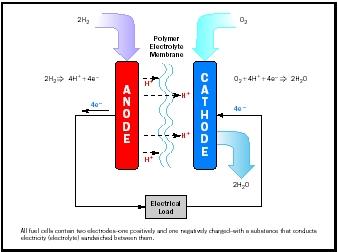Fuel Cell
Fuel cells convert chemical energy to electrical energy by combining hydrogen from fuel with oxygen from the air. Hydrogen fuel can be supplied in two ways—either directly as pure hydrogen gas or through a "fuel reformer" that converts hydrocarbon fuels such as methanol, natural gas, or gasoline into hydrogen-rich gas. A fuel cell's only emission is water.
Fuel cells have been used in the space program since the early 1960s and are currently used in approximately six hundred office buildings, industrial facilities, and hospitals in the United States. Most automobile makers are experimenting with fuel cell–powered vehicles. DaimlerChrysler and United Parcel Service are testing fuel cell–powered delivery vans and fuel cell–powered city buses are being tested in Washington, DC. In his 2003 State of the Union, President George W. Bush proposed spending $1.2 billion to fund fuel cell research.
All fuel cells contain two electrodes—one positively and one negatively charged—with a substance that conducts electricity (electrolyte) sandwiched between them. Fuel cells can achieve 40- to 70-percent efficiency, which is substantially greater than the 30-percent efficiency of the most efficient internal combustion engines. Differences in size, weight, cost, and operating temperature all affect potential uses and, for a variety of reasons, a number of fuel cell technologies are not practical for transportation. The Proton Exchange Membrane (PEM) fuel cell is the focus of vehicle-power research. The following are the major different types of fuel cells:
- Proton exchange membrane (PEM—sometimes also called "polymer electrolyte membrane"): Considered the leading fuel cell type for passenger car application; operates at relatively low temperatures and has a high power density.
- Phosphoric acid: The most commercially developed fuel cell; generates electricity at more than 40-percent efficiency.

- Molten carbonate: Promises high fuel-to-electricity efficiencies and the ability to utilize coal-based fuels.
- Solid oxide: Can reach 60-percent power-generating efficiencies and be employed for large, high powered applications such as industrial generating stations.
- Alkaline: Used extensively by the space program; can achieve 70-percent power-generating efficiencies, but is considered too costly for transportation applications.
- Direct methanol: Expected efficiencies of 40 percent with low operating temperatures; able to use hydrogen from methanol without a reformer. (A reformer is a device that produces hydrogen from another fuel like natural gas, methanol, or gasoline for use in a fuel cell.)
- Regenerative: Currently being researched by the National Aeronautics and Space Administration (NASA); closed loop form of power generation that uses solar energy to separate water into hydrogen and oxygen.
The main difficulties in employing fuel cells on a large scale are the source and storage of hydrogen and conversion from a gasoline to a hydrogen refueling infrastructure. Ideally, hydrogen can be obtained by breaking down water with solar electrical power to produce hydrogen and oxygen. Major U.S. oil companies are already extracting hydrogen from gasoline for industrial uses and natural gas can be reacted with steam to form hydrogen in a process known as steam reforming. However both methods also produce carbon dioxide, a greenhouse gas. To power vehicles over reasonable distances hydrogen gas must be stored at extremely high pressures or as a liquid at very low temperatures. Researchers are looking at ways to store hydrogen in solids, such as super porous nanotech materials that soak up hydrogen like a sponge. It can also be extracted from methane, natural gas or gasoline by a fuel processor that reduces efficiency and does emit some pollutants.
Patricia Hemminger